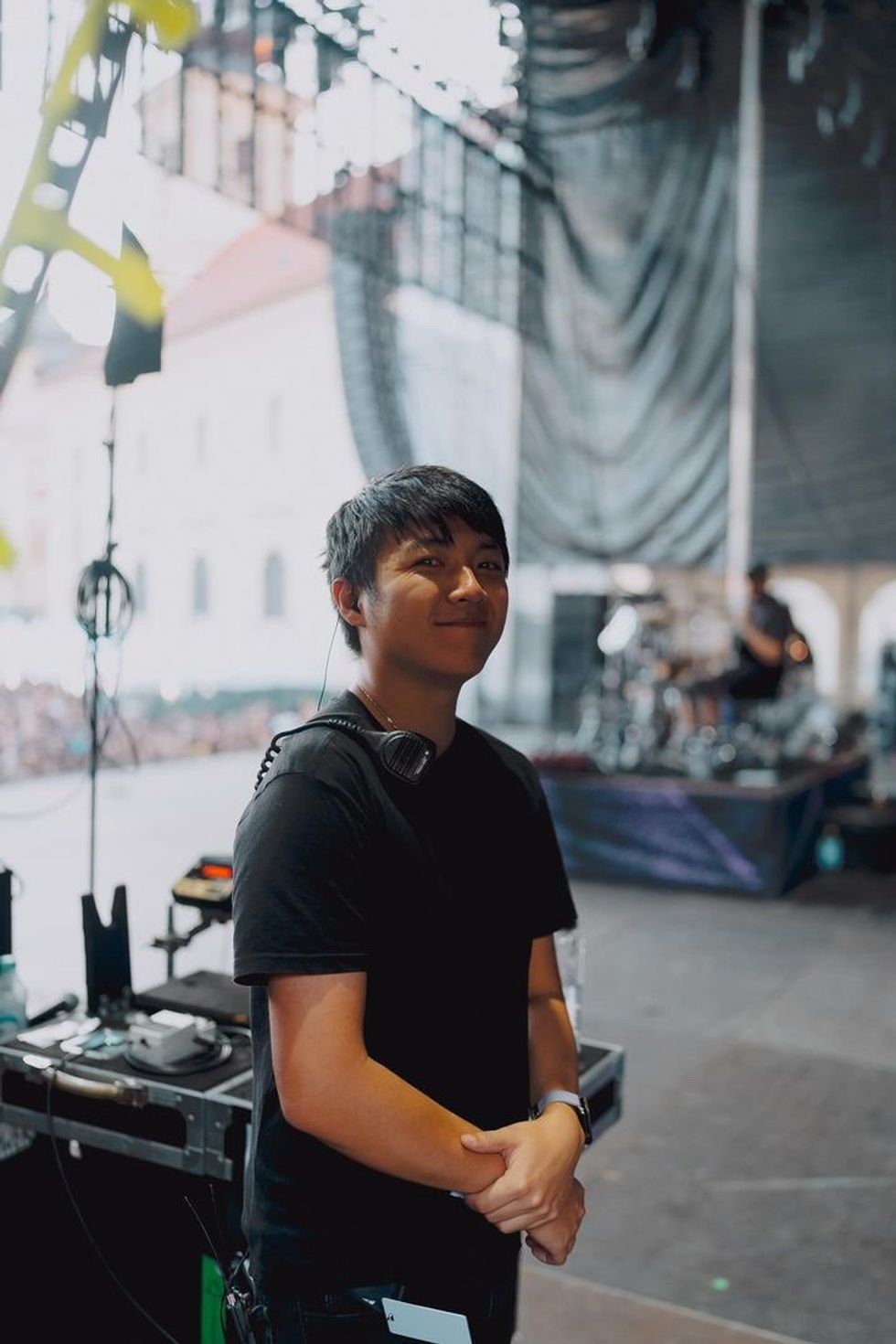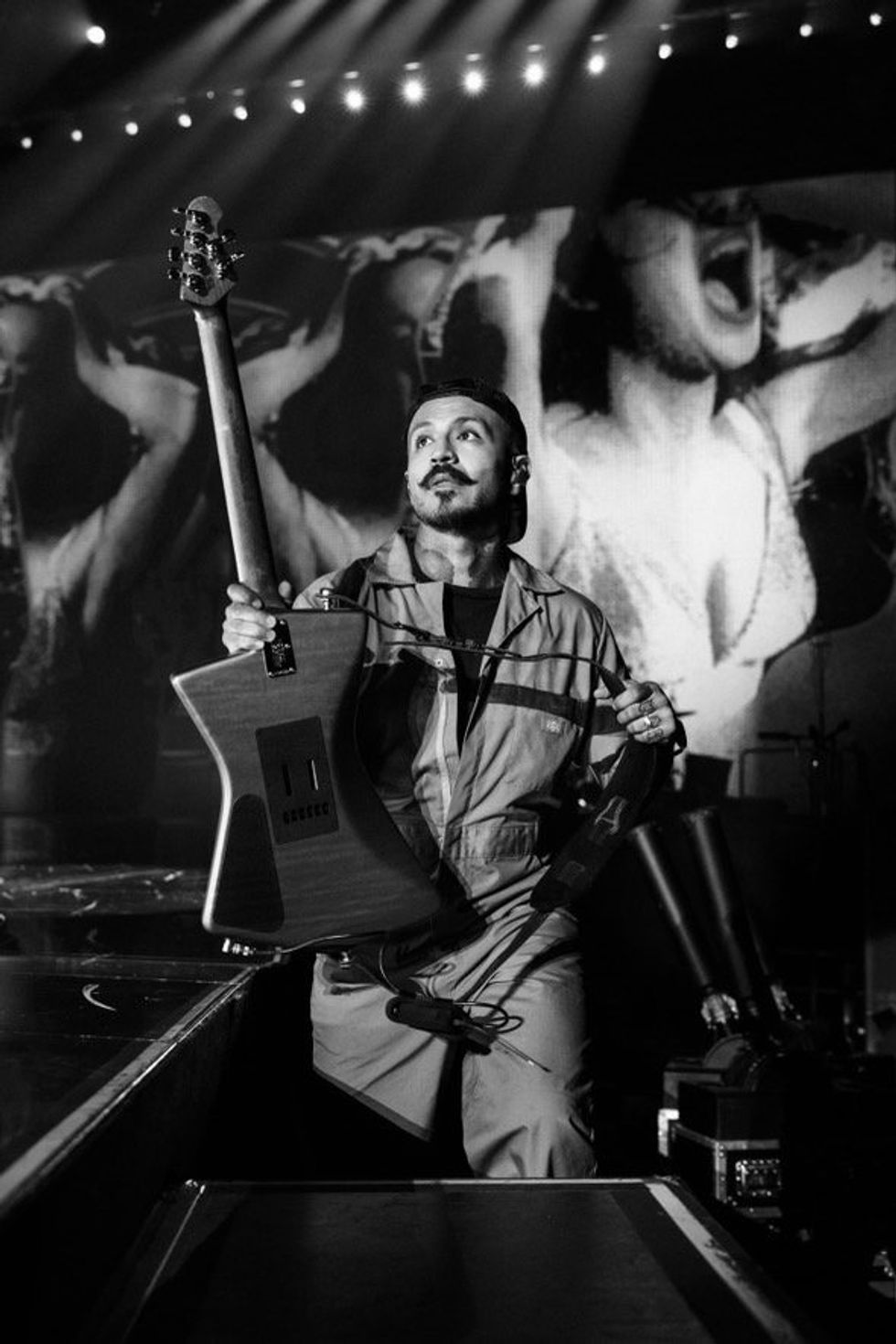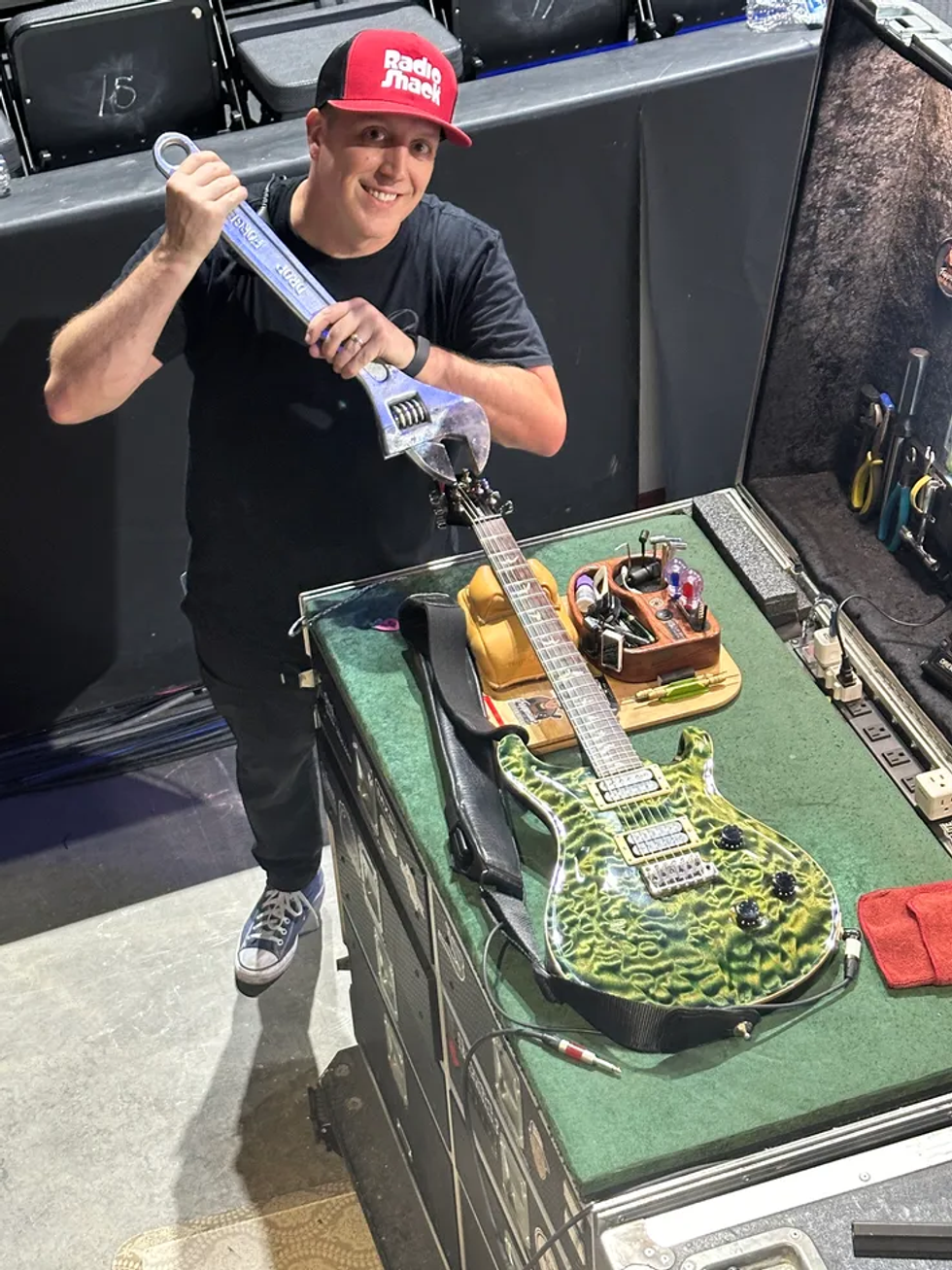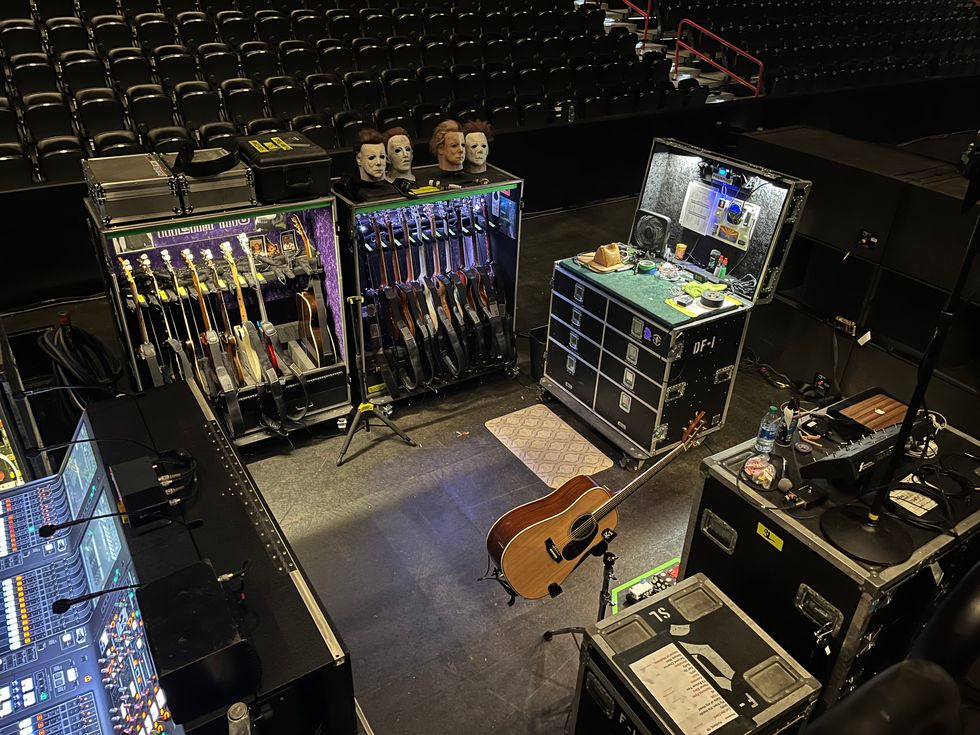In the early to mid 1970s, Miles Davis changed musical directions. That wasn’t unusual. Davis did this often—he was at the forefront of almost every innovation in jazz. But the direction of the 1973–75 incarnation of his band was unusual. Although Davis had already gone electric in 1969 with the release of In a Silent Way, as radical as some of his early electric work was, it was nothing compared to the bombastically epic avant-funk he’d unleash just a few years later. And at the epicenter of that mid-’70s lineup—the nuclear bomb Davis dropped on jazz—was the late, great guitarist Pete Cosey.
Cosey was an imposing figure: A large man with big hair and a long beard wearing flowing robes and dark glasses. He performed seated and was surrounded by guitars, handheld percussion instruments, and a floor full of stompboxes. And his playing was unlike anything else. It was a sonic adventure—innovative, complex, dissonant, abrasive, yet ambient, subtle, and rooted in the blues. It was always tasteful and appropriate, regardless of how far out he took it.
But Cosey was no newcomer when he joined Davis. His impressive resume included stints with a who’s who of the late-’60s Chicago scene—serious gigs with big names in R&B, early funk, blues, psychedelia, straight-ahead jazz, and the city’s burgeoning avant-garde movement. An insatiable tinkerer, Cosey experimented with tunings, pedals, synths, and butchered instruments in his never-ending quest for an elusive tone.
Mainstream success eluded Cosey, but his reputation and influence are massive. His former collaborators adored him. His protégés revered him. Most consider it criminal that he never reached a larger audience. He was a singular and uncompromising talent—his music was an extension of who he was—and in the process, he redefined the way the guitar is played.
The Explorer
Peter Palus Cosey was born in Chicago on October 9, 1943. His mother worked as a pianist and songwriter. His father played the saxophone and worked with people like swing-jazz pioneer Louis Jordan, bluesman Big Bill Broonzy, acclaimed jazz saxophonist Sidney Bechet, and French-American entertainer Josephine Baker.
an elusive tone.
Cosey moved with his mother to Phoenix, Arizona, following his father’s death when he was around 9 years old, but returned to Chicago as a young adult and remained there for most of his life.
Cosey played a number of different instruments. He had some formal training on piano, but he was a self-taught guitarist. He credited some of his later innovations on guitar—like alternate tunings and controlled feedback—to his earlier education, experimentation, and big ears. It also didn’t hurt that his parents created an environment that was open to world music and fostered exploration. For example, he told All About Jazz in May 2008, “I have an appreciation of [Indian] music through my father. He field-recorded in India, between 1936 and 1938. The first curry I ever tasted was prepared by my father, when I was a child.”
The future Davis sideman’s first major gig was as a session guitarist for Chess Records. “I must have done a thousand blues sessions,” he told writer George Cole in an interview for the book The Last Miles: The Music of Miles Davis, 1980-1991. He played on the incredible Fontella Bass hit “Rescue Me,” and did sessions with Etta James, Jackie Ross, Major Lance, and many others. He even worked with Chuck Berry. “[Berry] had just gotten out of prison,” Cosey told Cole. “We cut some great things with him—they were really rocking. I remember we did 31 takes of one song, only because he was rusty. They had me play his signature lick for him and it was an honor.”
But Cosey’s most notable work for Chess was on the label’s late-’60s psychedelic experiments featuring Muddy Waters and Howlin’ Wolf. The albums Electric Mud, The Howlin’ Wolf Album, and to a lesser extent, Waters’ follow up After the Rain, were a conscious effort by Chess to market the blues masters to a younger audience. The albums were a commercial success—Electric Mud was Waters’ biggest-selling album at Chess—although certain blues purists weren’t convinced. “I remember Pete telling me about how much Howlin’ Wolf hated his playing,” says Cosey collaborator and bassist Melvin Gibbs (Rollins Band, Defunkt, Decoding Society). “Muddy was maybe half convinced when they recorded Electric Mud, but once that first album sold so well he was, like, ‘Yeah, I love this boy.’ But Howlin’ Wolf was never convinced. Pete told me that Wolf told him—Pete had a big afro at that time—‘Yeah boy, you need to go get a haircut, and while you’re on your way to the barber shop, take that bow-wow pedal of yours and throw it in the lake.’”
Cosey, in his customary seated position (center left in green pants and shades), onstage with Miles Davis in Japan.
Photo courtesy of Sony Music
Despite Howlin’ Wolf’s misgivings, Cosey’s playing on those records shines like that of an original, mature musician and hints at what was to come. Some of his best performances are on Electric Mud’s “I Just Want to Make Love to You” and “Herbert Harper’s Free Press News.” Cosey’s sound is the real deal—someone steeped in the traditions of the Chicago scene, pushing the sonic envelope, stretching out harmonically, yet stamping it all with his unique thinking and personality. Cosey wasn’t a student of a tradition. He was a living extension of that tradition, constantly building on it.
“Those are some of the greatest albums ever,” Gibbs says. “I’ve heard that Led Zeppelin used to listen to those albums before they went onstage. That’s the level of influence they had.” Although difficult to corroborate, legends abound. In addition to Zeppelin, Jimi Hendrix and the Rolling Stones are said to have drawn inspiration from those albums. Years later, hip-hop icon Chuck D of Public Enemy championed Electric Mud by reassembling the original band for the “Godfathers and Sons” episode of the 2003 Martin Scorsese-produced documentary series, The Blues.
Already somewhat of a gearhead, Cosey had a small arsenal of go-to instruments at that time. “Pete used his trusty Gretsch Tennessean, along with a ’58 Fender Stratocaster and a customized Gibson ES-125 modified by Phoenix luthier Bill Ross to include 24 frets and a single cutaway,” Bill Milkowski wrote in Guitar Player in July 1990, describing the instruments Cosey favored as a session man.
In this 2009 photo, Pete Cosey strums the very same Morris Mando Mania guitar he often played onstage with
Miles Davis in the ’70s. Photo by Audrey Cho
Cosey’s work wasn’t limited to Chess in those days either. He toured with Aretha Franklin, Jerry Butler, and did sessions for Motown as well. “We did a lot of work together when I came to Chicago to the Regal Theater,” says Michael Henderson, who played bass with the Davis lineup in the ’70s. “Pete was in the house band there with [jazz drummer and bandleader] Red Saunders. He was also in the Pharaohs with Louis Satterfield—and that was the precursor of Earth, Wind & Fire.”
But there was a lot more to Cosey than blues and R&B. “I have a great appreciation for Kenny Burrell, Joe Pass, Tal Farlow, Grant Green,” he told Cole. “I loved Wes Montgomery. To listen to my playing, you wouldn’t imagine that I had been through that kind of music, but man, I used to play Wes stuff up and down.” That knowledge came in handy when he joined up with saxophonist Gene Ammons. “He definitely had to play bebop,” says David Liebman—the sax player and flautist with Cosey in Davis’ band—regarding Cosey’s role in the Ammons band. “Pete could do a lot of things. He seemed to be a well-schooled guy.”
Experimental guitarist Henry Kaiser also notes that Cosey was a virtuoso in multiple complicated genres. “Pete Cosey had many different systems of music,” Kaiser says. “He understood Asian music, Indian music, 20th-century classical music, and many different kinds of harmony and ways of organizing melody, harmony, and pitch. He used all of those tools—a very wide set of tools—wider than most people would use.”
Cosey was also an early member of the Association for the Advancement of Creative Musicians (AACM), a Chicago-area collaborative that included Muhal Richard Abrams, Henry Threadgill, Anthony Braxton, Jack DeJohnette, the Art Ensemble of Chicago, and many others on the frontiers of jazz and modern original music. That involvement with his city’s avant-garde scene, together with his background in blues, funk, and jazz, made him an ideal candidate to work with Miles Davis.
The Miles Years
Cosey started working with Davis in 1973. At the time, Davis had Indian musicians on sitar and tabla, but he streamlined the ensemble soon after Cosey joined. “The Indian instruments lasted another month or two, and then Miles cut the band down,” says Liebman. “He even got rid of the keyboard—he played keyboards himself when he wanted them.”
Davis’ Cosey-era band was a cultural statement as well. “Miles gave me three directions while I was with him,” Cosey told Cole. “The first was to move up front … [the second was] to turn up [the volume] … And the third thing he said was, ‘Sit there and look black!’”
Gibbs adds some nuance to that. “Miles really wanted to make the band black, and that was Pete’s thing in Chicago. His function was basically to bring what my friend [founding Black Rock Coalition member] Greg Tate calls ‘African continuum’ into the band. Obviously [percussionist] James Mtume had already brought that in, but Pete was like the final touch.”
Davis’ music at that point was slowly evolving toward lengthy funk grooves and structured group improve, and was influenced by artists as disparate as Sly Stone and Karlheinz Stockhausen. The band was loud and funky, and Cosey’s job was to add an element of Hendrix. “Since I couldn’t get Jimi or B.B. King, I had to settle for the next best player out there,” Davis wrote in his autobiography. “Pete gave me that Jimi Hendrix and Muddy Waters sound that I wanted.”
But aside from using distortion and wah-wah, Cosey didn’t sound anything like Hendrix. “Pete was Pete. Pete would have existed if Hendrix didn’t exist,” Gibbs says. “You listen to the little things he did—you take Chicago, electrify it, add some of the things he was doing on the jazz side, fuzz it up—and you’re going to get Pete.”
For one thing, Hendrix and Cosey had very different approaches to tone. Hendrix cranked his amp and pushed a lot of air. He used pedals as well, but his amp was central to his tone. Cosey’s approach was the opposite. “Pete knew how to get all these sounds at a very low volume,” Kaiser says. “He used pedals more than the amp to get his sound. He knew how to misuse pedals, too, like plugging the chord halfway in to get what we think of as Fuzz Factory-type sounds now. He knew the difference between having the fuzz before and after the wah. He had all the pedal tricks figured out.”
Cosey didn’t travel with an amp, though he had his preferences. “I liked the Yamaha equipment best,” he explained to Milkowski. “It gave me more highs, as opposed to the meatier sound you get with Marshalls. The Sunns were really powerful and sounded good, but the Yamaha equipment seemed to work best with my pedals.”
According to Henderson, Cosey sounded like Cosey regardless of the gear. “He could duplicate that sound through any amp,” Henderson says. “Once you know what your sound is, it’s not really about the amp that much. You are the instrument, and your tone and your sound on whatever you play is going to have that same attitude—even if you’re tapping on the table. His DNA, so to speak, generated what you heard out of the speakers.”
Another distinguishing feature of Cosey’s playing was how he tuned his guitars. “He never played in standard tuning,” Henderson says. “He would tune to the way he wanted to play the chords—the way he wanted them to sound—because the different tunings make your approach quite different.”
Miles Davis (third from right), Pete Cosey (far left), and the band chill with food and beverages in this circa-1970s photo.
Photo courtesy of Miriama Cosey
Gibbs laughs as he recalls his experiences with Cosey and tunings. “Pete had, like, a gazillion tunings—which he didn’t share! He used different tuning systems for different songs, and that was an integral part of his approach. We did some gigs where I didn’t send him the music ahead of time. I realized later that he wanted music ahead of time so he could listen to everything and adjust it to his tuning systems.”
Cosey even reserved different guitars for special tunings, although he wasn’t able to travel with all of them. “He tried to bring a lot of guitars with him on tour, but he couldn’t get them all on the plane,” Henderson says. “Miles cut him down to three. He had to reserve extra seats. Pete was a big guy, so he would have to have two seats for himself, then he would get extra seats for his guitars—and he had his pedals with him, too. There was no way you were getting him to put his instruments underneath the plane.”
A number of Miles Davis albums feature Cosey’s playing, the most significant being a trio of live albums—Dark Magus, Agharta, and Pangaea. The latter two were the afternoon and evening performances, respectively, from a single day in Osaka, Japan. Many critics consider Agharta the better album and praise Cosey’s exceptional playing on it as an example of instrument mastery, as well as a study in contrasts. He’s insanely fast at times, tasteful and atmospheric at others. He employs intense chromaticism and dissonance, yet is firmly grounded in the blues. His sense of phrasing is blistering and in your face, but somehow also restrained. He uses a small army of effects—a huge innovation for the time—and is in complete control of his feedback. His sonic sense is outstanding and totally original.
“He was like a funny combination of really bluesy shit and out stuff,” Liebman says. “He sat there with a table and all these pedals. He had the ability to make some really different kinds of sounds.”
Milkowski wrote that although Cosey played a variety of guitars during the Miles years, he primarily played an SG-like Guild for Agharta and Pangaea, and ’54 and ’59 Gibson Les Pauls for Dark Magus. He kept a ’61 Strat in reserve, just in case. A trademark of Cosey’s stage setup was a table loaded with assorted percussion instruments. He sat behind the table and put his effects—two wahs (a Morley for warm tones, a Halifax for solos, and sometimes a Vox Clyde McCoy), a Jordan Bosstone for dirt, and a Gibson pedal—underneath it. He also often used an EMS Synthi A synthesizer.
“Pete would try everything,” Gibbs says. “Every time I was with Pete he was trying a different guitar—he had, like, a Spinal Tap level of guitars. He had many different pedals, too, but he had a range of sound that he liked.” Cosey also used a Vox Phantom XII electric 12-string and a Morris Mando Mania guitar, among many others. “Another thing that’s really interesting about Pete is that he was one of the first people to mess with guitar synths,” Gibbs adds. Years later, in addition to the EMS Synthi A, he also had a headless Ibanez MIDI controller, a Roland guitar-synth controller, and a Yamaha TX81Z.
Post-Miles Pete
In 1975, Davis broke up the band and began a five-year hiatus from music. He and Cosey stayed in touch and did various sessions together, but for the most part Cosey stayed in Chicago and worked on other projects. He appeared on Herbie Hancock’s groundbreaking 1983 album, Future Shock. In addition to being a platinum-selling success, the album was revolutionary in its use of drum machines and record scratches, and it dominated MTV. The guitar solo on the title track, despite the serious ’80s surroundings, is classic Cosey—wide intervals, twisted dissonance, subtle whammy use, and unorthodox tones that stick out like thorns from a mix that otherwise conjures visions of badly-dancing club goers in pastel-shaded blazers with shoulder pads.
Cosey didn’t record much in the ’80s and ’90s, but he stayed busy leading various projects, teaming up with drummer Buddy Miles (Hendrix/Band of Gypsys), and working with Gibbs. “Pete became a member of the group Power Tools, which was myself, Ronald Shannon Jackson, and originally Bill Frisell,” Gibbs says. “Bill moved on, so we got Pete to come in.”
Gibbs used Cosey for a number of projects over the next 20 years, including a spectacular solo on “Canto por Odudua” from Gibbs’ 2012 Elevated Entity album, Ancients Speak. Cosey’s solo is what you’d expect—overdriven, dissonant, idiosyncratic, yet complementary and song appropriate—proof that despite a dearth of recorded output, the master still had it. And Gibbs has a backlog of recordings set for release. “We did a whole session based around the [1970 Miles Davis album] Bitches Brew,” he says. “I had a bunch of musicians play along to the original recording. I then took the original record away and mixed what they had played to it. Pete sounds great on that.”
Cosey was involved in many other projects, including the aforementioned “Godfathers and Sons” documentary episode, Greg Tate’s 2003 Burnt Sugar version of Stravinsky’s The Rite of Spring (conducted by Butch Morris), and free-jazz saxophonist Akira Sakata’s 2001 album Fisherman’s.com.
YouTube It
Miles Davis leads his band through a live performance of “Ife” in this 1973 footage. Check out Pete Cosey’s remarkable eclectic solo just after the five-minute mark—it goes from mellow, approachable jazz to nastily discordant and fuzzed-out wailing high up on the neck.
He led groups that included Gibbs, drummer JT Lewis, and DJ Johnny “Juice” Rosado (Public Enemy). He was also involved with educational programs as part of the Jazz Foundation’s Agnes Varis Jazz and Blues in the Schools program.
Cosey kept Davis’ music alive as well. He performed with Gibbs at the Davis tribute Wall-to-Wall Miles, and formed the group Children of Agharta to record and perform with the Grammy-nominated project Miles from India. “He had me come sit next to him during the long rehearsal,” says Kaiser—who subbed for Cosey on some live Miles from India performances that Cosey missed for health reasons. “He explained everything he was doing to me so I would know in case I had to substitute again. It was amazing to get to do that with one of my heroes.”
True to the End
Cosey was a powerful spirit. “I’ve had the opportunity to be around a lot of singular, influential people,” Gibbs says. “People like Ornette Coleman, Gil Evans. Pete was one of the most influential—without being influential—people in my life. He’s known because he made other people’s music happen: He made Miles’ music happen … he was part of that great Chess band. But a lot of his information is filtered out as being other people’s information.” He knew how to process his influences, internalize them, and make them his own. “Like I said, Pete would have existed even if Hendrix didn’t exist. Pete took that same pool of information and made a natural progression.”
Cosey told Cole, “I wasn’t living an easy life. I went through a lot of great struggles but I kept true to the music. I never lost sight of that. I never stopped experimenting, improving, and crystallizing, and creating, and I still do that. I realized a long time ago what my mission is and I’ve stayed true to that.”
Health issues became an increasingly difficult struggle for Cosey near the end of his life. According to the Chicago Tribune, he died of complications from an undisclosed surgery on May 30, 2012. He was 68. He left behind a legacy of incredible playing and a core group of people who loved him.
“If you learn anything from his playing then you learn something about the man,” Henderson says. “Pete Cosey was a way of life. He was a good man—he knew how to live—and you heard it in his playing.”
“He never played in standard tuning. He would tune to the way he wanted to play the chords—the way he wanted them to sound—because the different tunings make your approach quite different.” —Michael Henderson
Hallmarks of Cosey’s Style
Miles Davis went modal with his landmark 1959 release Kind of Blue. Based on the modal theories of composer and theorist George Russell, the music eschewed jazz’s traditional reliance on a never-ending succession of chord changes as the basis for improvisation. Instead, improvisers were given the freedom to explore and experiment within the context of a static mode or chord-scale.
Early modal compositions like Davis’ “So What” and John Coltrane’s “Impressions” still relied on a recognizable AABA form, but by the early ’70s, Davis’ music—inspired by musicians like Sly Stone and James Brown—sat on one groove, usually an ostinato bass line, which went on ad infinitum. “It was all vamps,” says David Liebman, who played sax with Miles during that time. “Miles had maybe a two-bar or four-bar riff, but it was really vamp music and soloing over the vamp.” During Pete Cosey’s tenure with Davis, it was not unusual for songs to go on for 20 minutes or more.
Davis experimented with complex rhythmic theories at that time as well. He assigned different instruments grooves to play in unrelated time signatures. Those grooves linked up every X number of bars, depending on how the various time signatures cycled in relationship to each other, and created intense polyrhythms in the process. But the harmonic setting was loose and gave the improviser incredible freedom to flourish.
It was a setting well suited for a player like Cosey. With his background in the blues and jazz—as well as funk, free, and various world-music genres—he had the awareness and experience to create soaring, open-ended melodic conversations. “Pete’s role with Miles was to do whatever he felt like—whatever he felt like was perfect,” Melvin Gibbs says. “Miles cued the band and it became the Pete show for about a half an hour after that.”
But modal playing is a far cry from easy. Although making complex, moving chord changes is challenging (try playing “Giant Steps” at breakneck speed), developing themes and ideas—without aimlessly wandering—is daunting as well. Cosey’s genius was his ability to thrive in that environment. He developed complex themes and variations and was a master of tension and release. He didn’t ramble and he kept the listener engaged. To hear him in action, check out the version of “Ife” and “Prelude (Part I)” from Agharta.


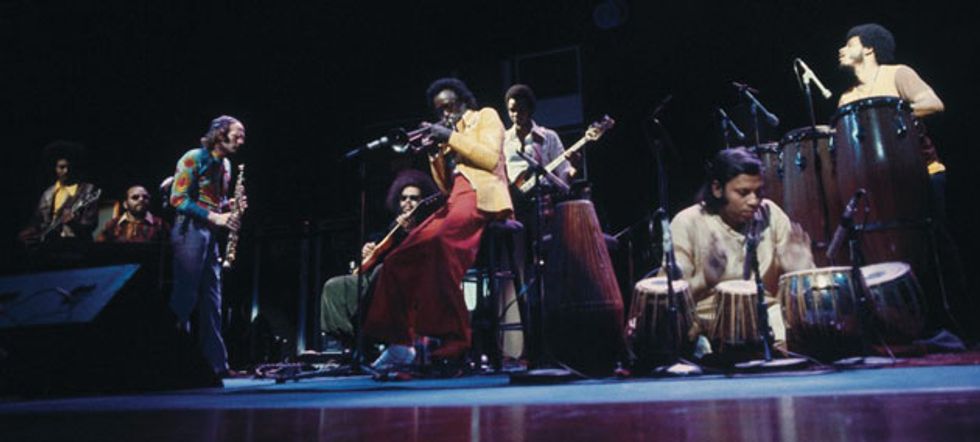
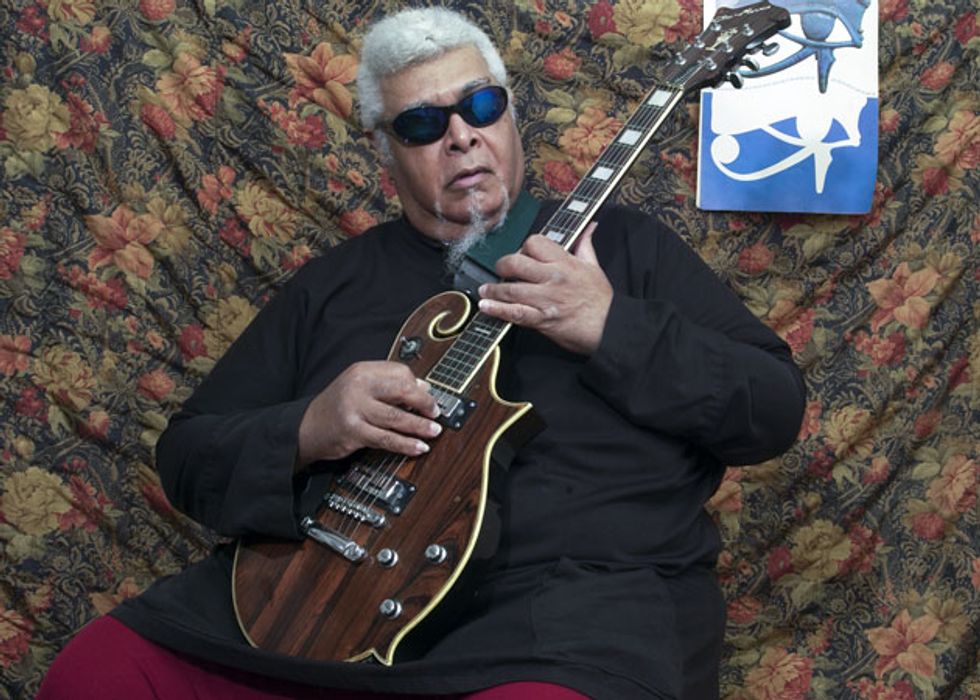
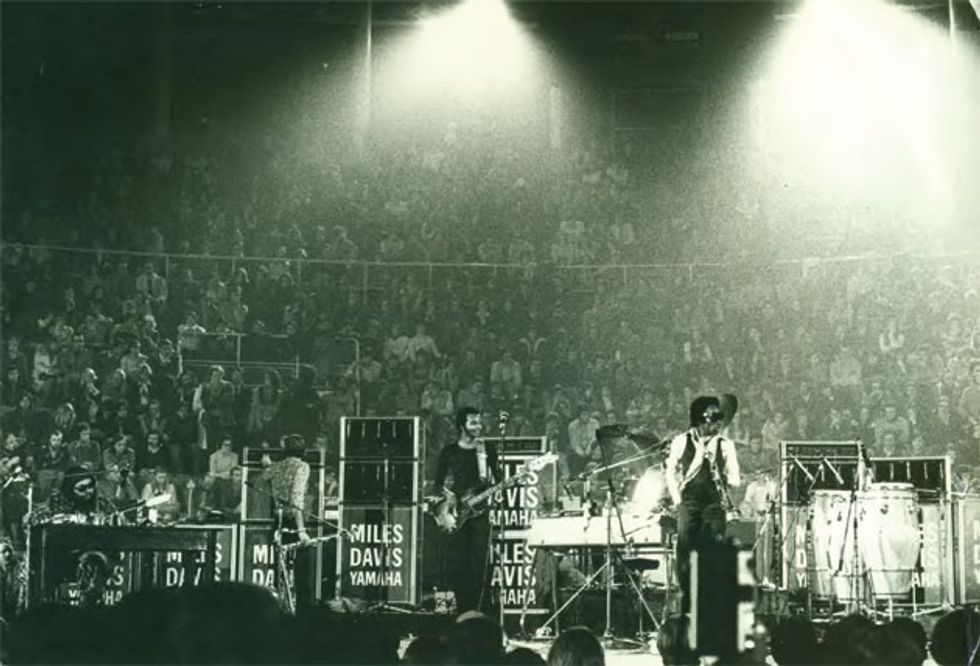
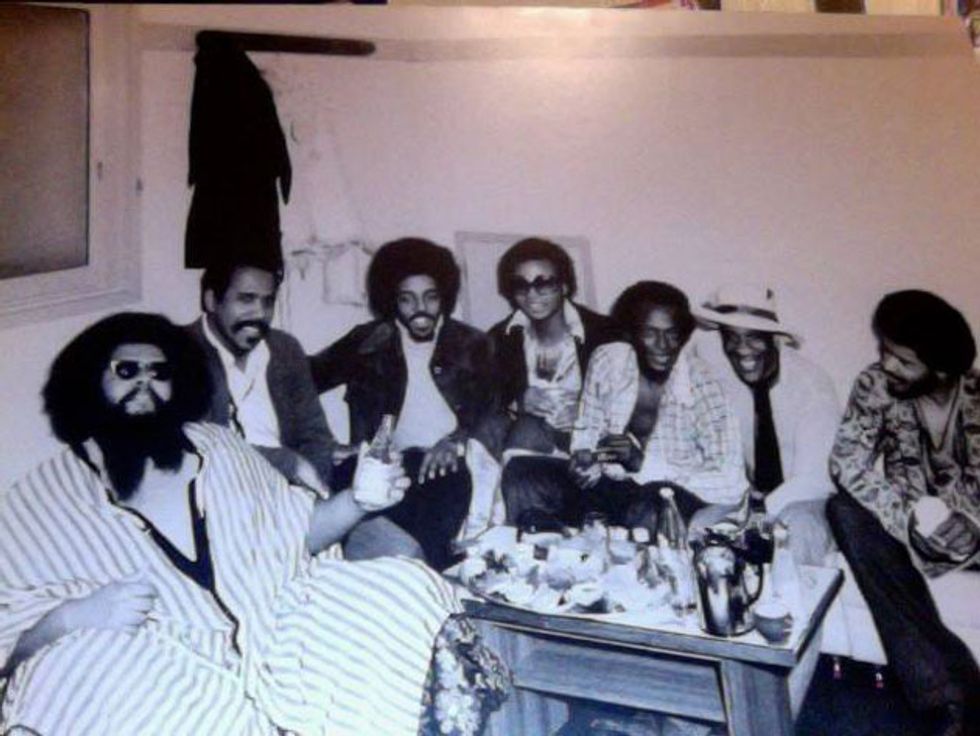
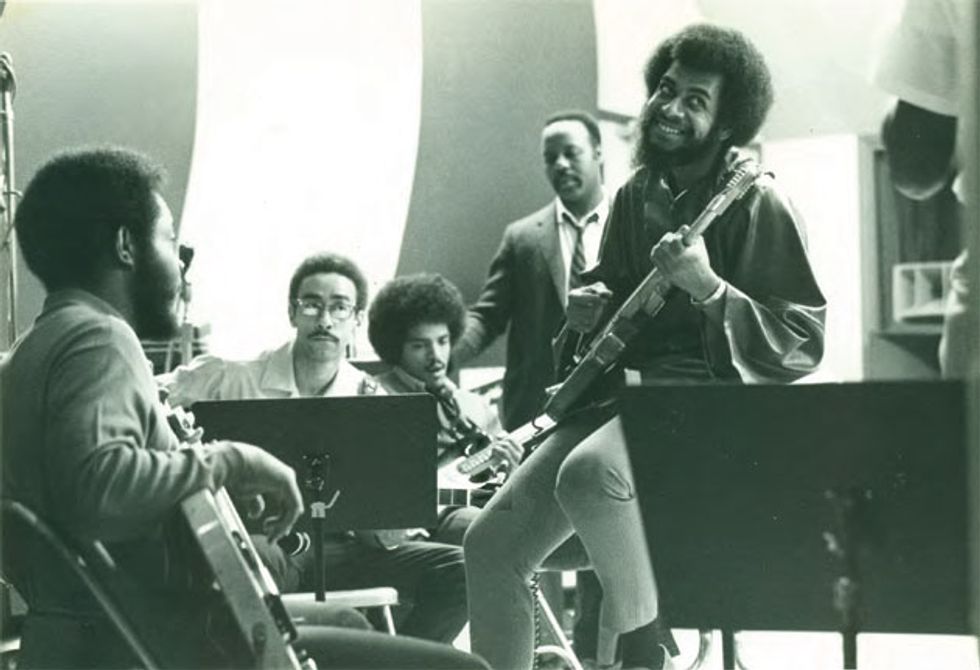
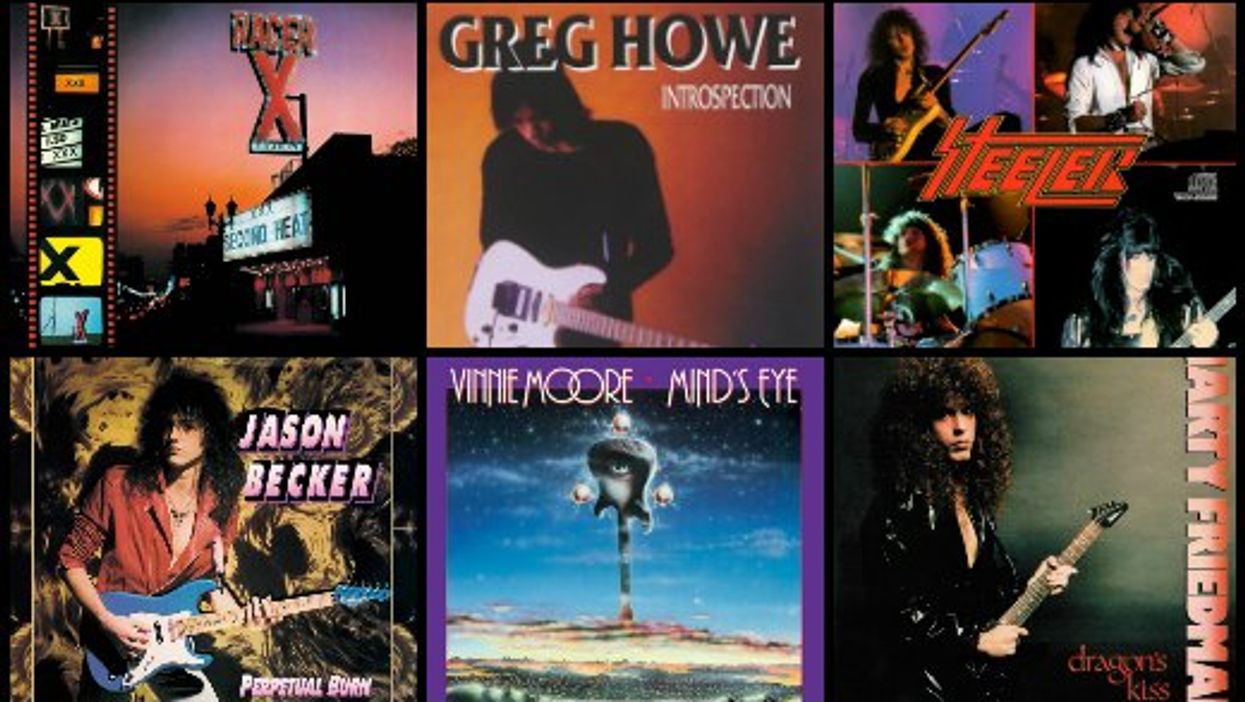
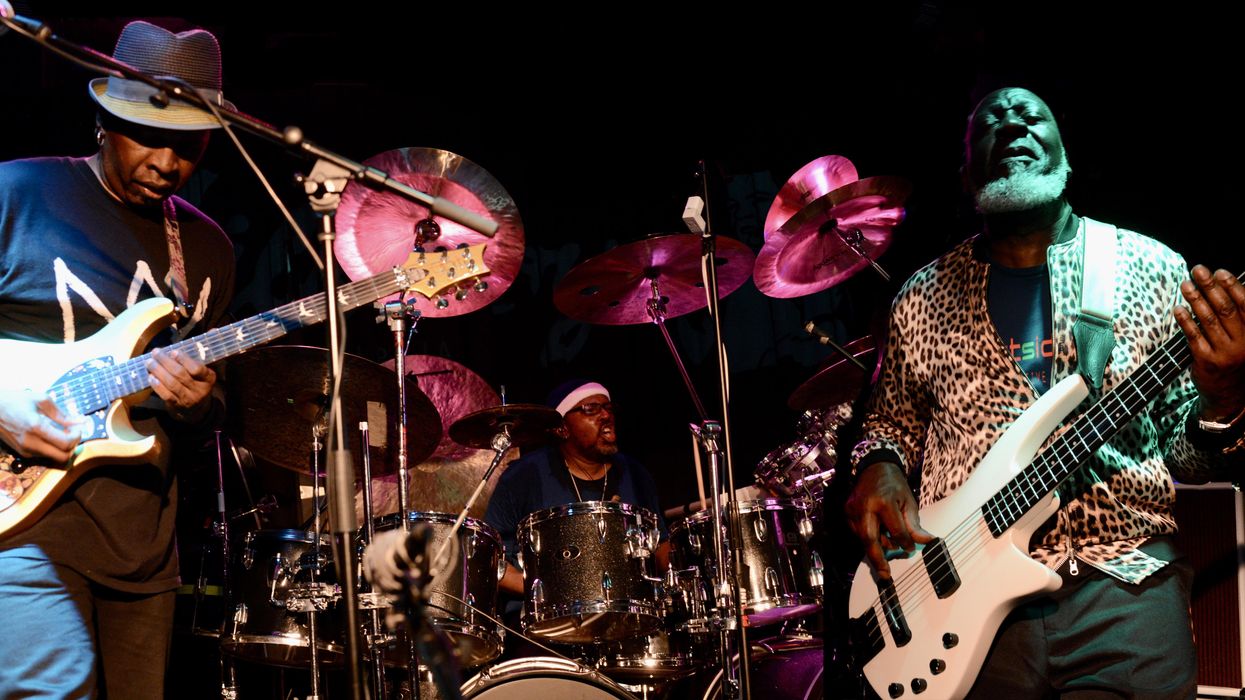


![Rig Rundown: AFI [2025]](https://www.premierguitar.com/media-library/youtube.jpg?id=62064741&width=1245&height=700&quality=70&coordinates=0%2C0%2C0%2C0)












 Shop Scott's Rig
Shop Scott's Rig



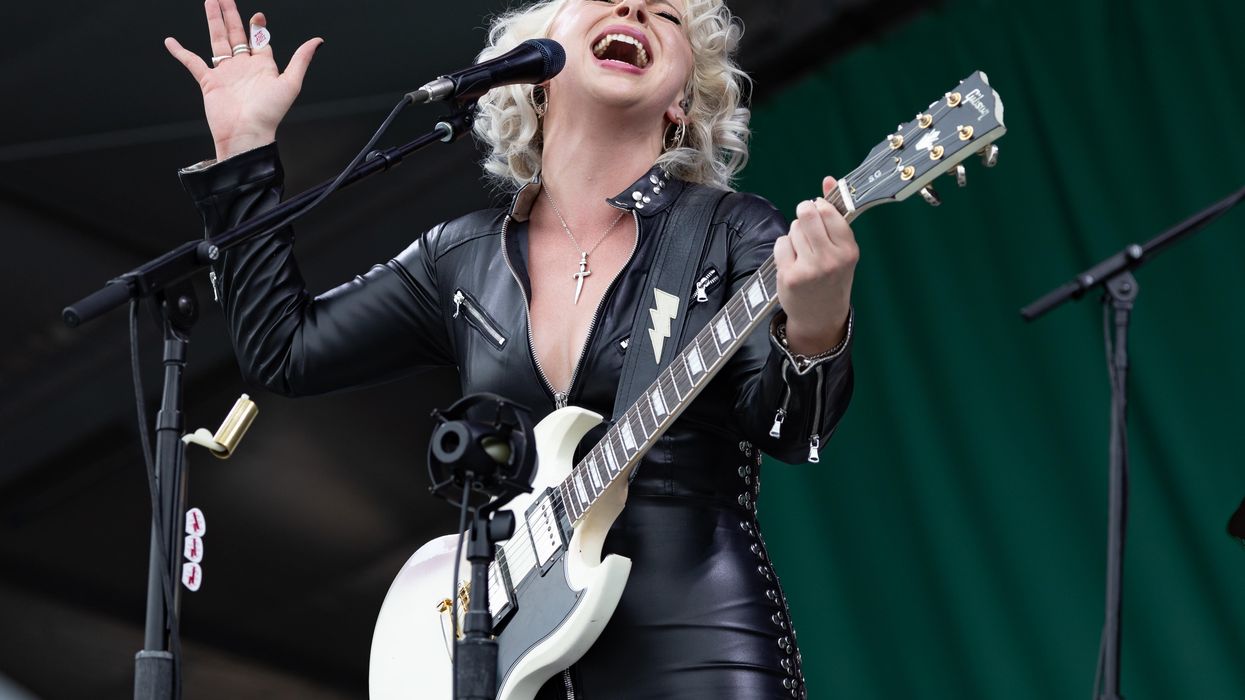

![Devon Eisenbarger [Katy Perry] Rig Rundown](https://www.premierguitar.com/media-library/youtube.jpg?id=61774583&width=1245&height=700&quality=70&coordinates=0%2C0%2C0%2C0)








 Zach loves his Sovtek Mig 60 head, which he plays through a cab he built himself at a pipe-organ shop in Denver. Every glue joint is lined with thin leather for maximum air tightness, and it’s stocked with Celestion G12M Greenback speakers.
Zach loves his Sovtek Mig 60 head, which he plays through a cab he built himself at a pipe-organ shop in Denver. Every glue joint is lined with thin leather for maximum air tightness, and it’s stocked with Celestion G12M Greenback speakers.













 Luis Munoz makes the catch.
Luis Munoz makes the catch.
